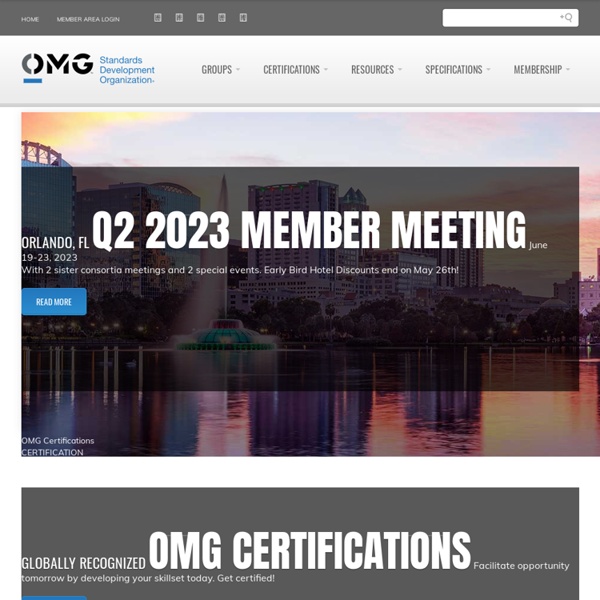



ARIS Express - Free Modeling Software Download your free of charge copy ofARIS Express right nowDownload for Free now!Version 2.4 available since Dec 19, 2012 ARIS Express is free of charge Perfect tool for occasional users and beginners in Business Process Management Intuitive user interface − modelers can work productively from the start Models for organizational structures, processes, application systems, data, and more Free training material available in ARIS Community All results can be re-used and enhanced in professional ARIS Platform products Share ARIS Express with your peers
MIPI™ MPHY - An introduction Design And Reuse Search IP IP Based SoC News BPMN Method and Style: An Example - Business Process Watch I’m always prattling on about “method and style” in BPMN modeling, and most folks probably don’t know what I’m talking about. My goal is maximizing shared understanding of the BPMN diagram, so it is clear and complete to anyone looking at it, even if the reader is unfamiliar with the process or the modeler’s terminology. That requires going beyond the requirements spelled out in the BPMN spec to a set of modeling conventions aimed at reducing the need for prior familiarity with the process in order to understand the diagram. “Completeness” also implies (to me) understanding at a glance how the process starts, what the instance represents, the possible end states of the process, and the interactions between the process and external entities, such as the requester, service providers, and other internal processes.
Activity Diagram - Activity Diagram Symbols, Examples, and More What is an Activity Diagram? An activity diagram visually presents a series of actions or flow of control in a system similar to a flowchart or a data flow diagram. Activity diagrams are often used in business process modeling. GNU Radio - Tutorials - gnuradio.org Beginner-level tutorials¶ Note that even as a GNU Radio beginner, you'll be delving into the realm of software defined radio, which is a complex field. Core concepts of GNU Radio applications - A must-read for everyoneWritePythonApplications - A tutorial on how to develop Python GNU Radio applications. Some DSP and programming background required.QTGUI Tutorial - A tutorial on how to develop Python GNU Radio applications. Some DSP and programming background required.Tom Rondeau's gr-tutorial - Some tutorials from the boss himself.Simulations - A tutorial on how to use GNU Radio without hardware to verify performance and simulate RF conditions.
Australian Business Excellence Framework The Australian Business Excellence Framework (ABEF) is an integrated leadership and management system that describes the elements essential to organisations sustaining high levels of performance. It can be used to assess and improve any aspect of an organisation, including leadership, strategy and planning, people, information and knowledge, safety, service delivery, product quality and bottom-line results. The ABEF provides organisations with assurance of their sustainable performance and is Australia’s preferred framework for leadership and governance. The ABEF is proven to bring about powerful changes in organisational performance and culture. Organisations using the ABEF are able to develop business resilience and an integrated focus on sustainable performance. The ABEF is based on enduring Principles of Business Excellence that form the basis of a unified theory of management.
UML activity diagrams are UML behavior diagrams which show flow of control or object flow with emphasis on the sequence and conditions of the flow. Activity diagram is UML behavior diagram which shows flow of control or object flow with emphasis on the sequence and conditions of the flow. The actions coordinated by activity models can be initiated because other actions finish executing, because objects and data become available, or because some events external to the flow occur. The following nodes and edges are typically drawn on UML activity diagrams: activity, partition, action, object, control, activity edge. You can find some activity diagram examples here: Activity Activity is a parameterized behavior represented as coordinated flow of actions.
rtl-sdr – OsmoSDR DVB-T dongles based on the Realtek RTL2832U can be used as a cheap SDR, since the chip allows transferring the raw I/Q samples to the host, which is officially used for DAB/DAB+/FM demodulation. The possibility of this has been discovered by Eric Fry (History and Discovery of RTLSDR). Antti Palosaari has not been involved in development of rtl-sdr. Plan-Do-Check-Act Cycle (PDCA Cycle) Looking for more on the PDCA model? Try Plan-Do-Study-Act (PDSA) Plus QTools™ Training: Also called: PDCA, plan–do–study–act (PDSA) cycle, Deming cycle, Shewhart cycle The plan–do–check–act cycle (Figure 1) is a four–step model for carrying out change. Just as a circle has no end, the PDCA cycle should be repeated again and again for continuous improvement. UML Component Diagram, Design Elements TEN RELATED HOW TO's: Business Process Elements: SwimlanesConceptDraw has 142 vector stencils in the 8 libraries that helps you to start using software for designing own Business Process Diagrams. Use Swimlanes library with 20 objects from BPMN. Read more..
Watching planes with software-defined radio In this post we look at how USB DVB-T hardware can be used with software-defined radio (SDR) to create a low cost aviation Mode S receiver. Modern aircraft are fitted with “Mode S” transponders that can be interrogated by air traffic control radar in order to ascertain their position and heading. Hobbyist equipment for receiving these transmissions has been available for some time and typically costs hundreds of pounds. But it's now possible to re-purpose DVB-T hardware costing around £20 to create an SDR-based receiver. gr-air-modes